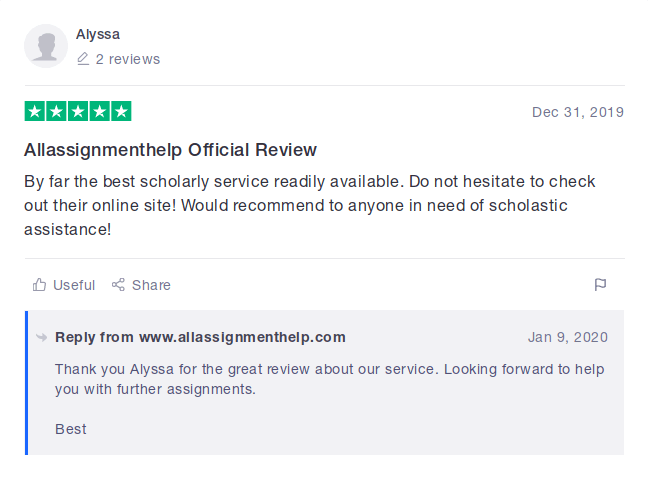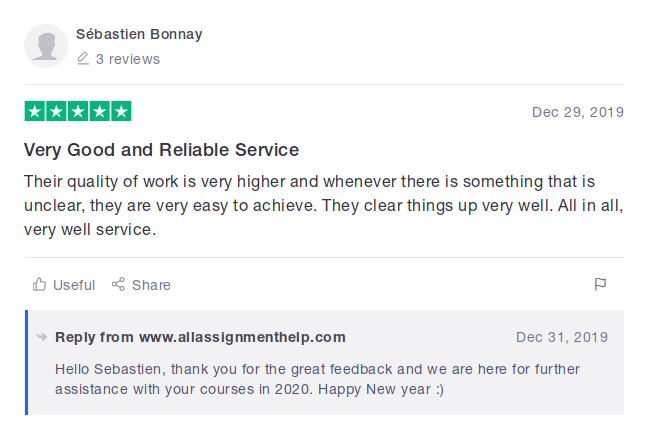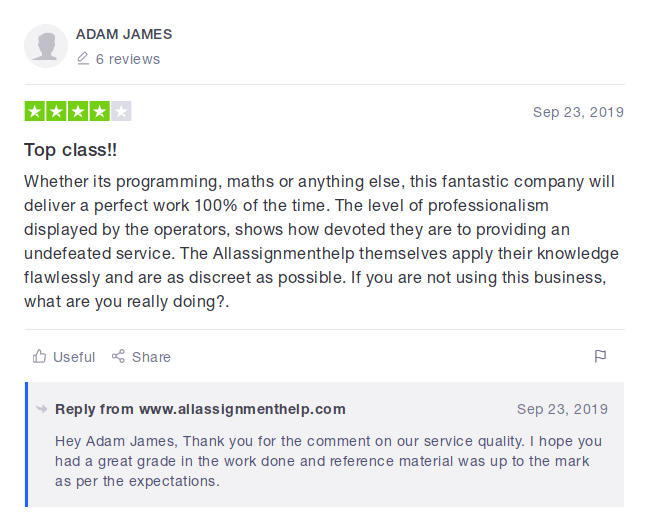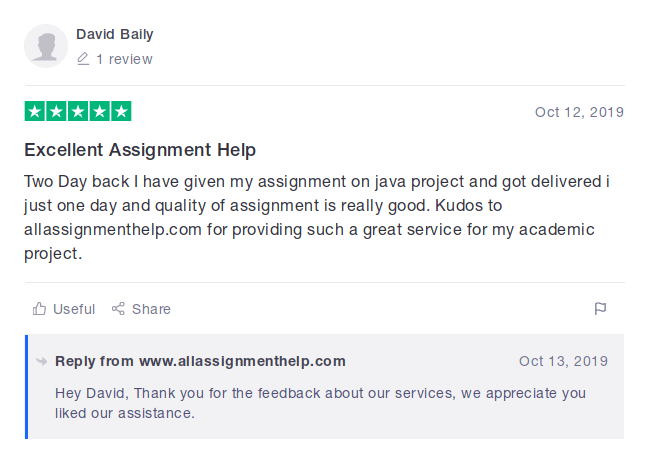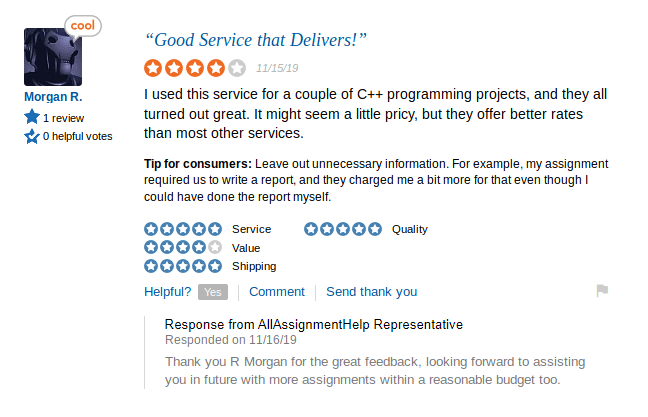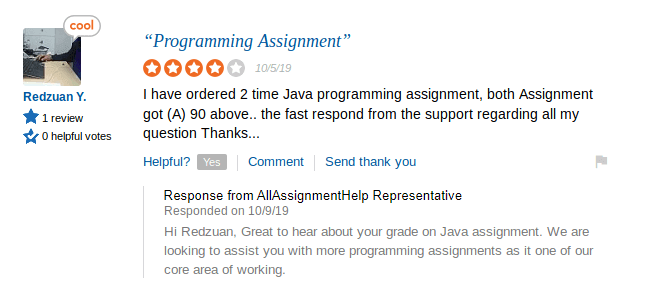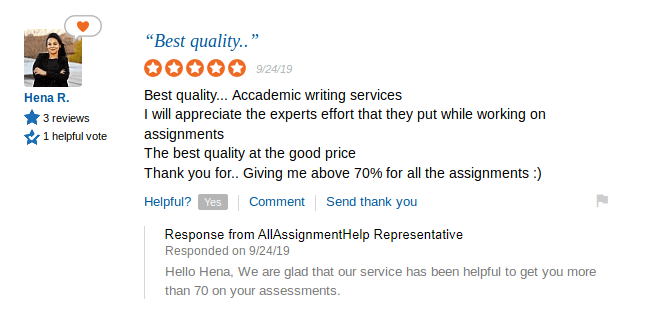Why students order last minute assistance with assignments from us
You have the flexibility to chose an assignment expert that suits your budget and quality parameters. We have more than 2000 PhD experts available to assist with assignments.
-
Order Preview Before Final Work
You get a preview before making final payment.
-
Pay Using different channels
You can pay using multiple secure channels, such as PayPal or Credit Cards.
-
Plagiarism Free Work Guaranteed
We sent unique content with no plagiarism.
-
Ping Us On Live Chat
You can talk to us anytime around the clock. We are up for the support.
-
Choose Your Own Expert
We let you chose from the pool of 2000 PhDs tutors.
-
Go Mobile
You do not need to be on laptop all the time, our mobile interface is great to use.
Reviews and Trust Go Hand In Hand
Allassignmenthelp.com has garnered nothing but praise from the clients. Any trustworthy review platform has positive review about our service and gives us motivation to improve.
Claim Your Offer
30% OFF & 150% Cashback on your First order !
Type your whatsapp number to get an exclusive code.
Recent Completed Projects
You can look at some of the samples that we did recently, we strongly recommend not to use samples for writing your assignment.
Thinking of where to avail pocket friendly services?
Save your money and time with us.
Place Your OrderExecutive Summary
The current report is the critical analysis of the project management plan developed for the Hilton Hotel (Auckland). The project plan of the hotel is to implement automated mechanism to operate the various electronic appliances within the hotel such as television, water geyser, doors, windows, curtains, and others such electronic elements. The project plan had some major missing aspects that have been recommended to be improved. Some of them are introduction of agile methodology to aide in the communication, bringing into picture the risk mitigation strategies so that the top management can make appropriate decisions about the project. Overall, the project plan has considered significant sections that are appreciable. The project procurement required more detail as it is important to understand whether the procurement of resources as per the standard and within budget. Apart from that, the human resource management plan requires detail on the bringing in the individuals for the project along with their skills and area specialization.
1. Introduction
The paper examines the project management plan for the Hilton Hotels. The project management plan for the hotel has been developed and is expected to be implemented in the days to come. This paper will analyse the developed plan and the elements that were considered along with the improvement areas. The analysis has been done in considering the theories that have been developed in relation to the project management plan.
Hilton Hotels and Restaurants is a big chain of hotels started by Conrad Hotel in 1919. The purpose of the project management plan developed for this hotel is to implement the system that would be fully automated such as automated room lighting system, auto-temperature adjustment, alarm system, automated television, and other things. The expectation is to install a system that is fully integrated and can be managed through the smartphones of the customers and also from the central control room of the individual hotels. The appendix I shows the activities that were defined for this project along with the deadline for each of the activities. The use of MS Project Software was facilitated to develop the plan and schedule the activities.
The second chapter of this report gives brief introduction of the project considered for the assessment. The third chapter discusses the audience and the structure of the project plan and whether there exists any alternatives for the existing plan. The fourth chapter analyses the contents of the project management plan such as scope, schedules, etc. The fifth and sixth chapter concludes the paper and recommends appropriate elements for the plan respectively.
"I am very happy with the quality of the assignments that I received. My professors appreciated me for the work and I got really good grades. It was like I invested my money at the right place. Thanks to the professional writers. I am going to recommend Allassignmenthelp to my friends as well."
Carry Martin,
New Zealand
2. Project Background
The project management plan has been developed for the Hilton Hotels chain. The competition in the market is gradually increasing and it has become important for this hotel to constantly upgrade to stay ahead of the competition (Holjevac, 2003). Therefore, the organization has planned to upgrade the facilities within the hotels by considering the technologically advanced equipment. The plan is to install fully automatic system within the hotels that will take care of the Air Conditioners, television, doors, windows, heater, water geyser, andbooking system that considers customer’s preference prior to their arrival. The integration of these elements will be done for the android and iOS based smartphones, and for windows. These operating systems are prevalently used by the masses and can capture large part of the customer base.
The project will be implemented in one of the hotels prior to beginning the phased implementation to the other hotels around the world. The plan that has been developed is for the one hotel initially. The investment in the project is from the hotel owner Conrad. There are various aspects of plan considered for the effective implementation, namely, project integration (to ensure effective integration of all aspects of the project), scope management (to define the premise of the project), time management (to define time for each activity to effective tracking), cost and quality management, human resource management, communication management, risk and procurement management (Dick et al, 1996).
3. Audience and Structure of Project Management Plan
This chapter analyses the audience of the plan developed for the hotel chain and whether there is any alternatives for this plan.
3.1 Intended audience to PM Plan
The audience or the individuals for whom the project is to be developed are an integral part of any project management plan (Snijders, Wuttke and Zandhuis, 2009).If the audience of the plan is considered and not the actual implemented project, then it can be stated that the target audience is wide. It includes hotel management, the individuals who are working on the project (project manager and project team), and board of directors. The final users of the project will be the employees and the customers of the hotels who will be actually using the system on daily basis. The audience is expected to know whether the developed plan will be successfully implemented within the defined budget and timeframe. The major concern can be expected from the audience who is going to invest in the project, which is the board of directors. Another important audience is the investor group whose money will be invested in the development of this project (Cleland, 1986). The main concern would be to know that whether the plan will bring any return as expected. Apart from that, they would like to know whether the elements considered in the project are sufficient enough for the effective implementation of the project.
The plan should provide the timeline within which the project will be completed(Snijders, Wuttke and Zandhuis, 2009). This will ensure that the stakeholders prepare themselves accordingly for the expected results from the new implementation. Another aspect is the presence of the budget within the plan. The concerned audience would like to know the amount that is to be invested in the project and whether they are willing to invest that much amount. The budget and timeline is followed by the activities that are to be conducted in the project. The upper management and the board of directors will be concerned with the macro view of the project plan only such as things to be implemented (automated appliances accessible through the smartphones and computers). On the other hand, the project team will be concerned with the specific details of the activities along with who will be working on each activity and when. As visible from the Appendix I, all these information are present in the table derived from the MS Project. Moreover, they would like to know about the tasks that need to be completed in early phase of the project and the tasks that are to be completed in the latter phases. The project plan (Appendix I) shows the predecessors depicting the same.
The plan should also contain the provision for the periodic reporting to the management, board of directors, and the shareholders as they would be interested in the progress of the project during its implementation phase(Snijders, Wuttke and Zandhuis, 2009). The presence of this aspect in the project plan is important.As visible from the Gantt chart in the Appendix II, the plan is based on waterfall methodology that allows little to no room for the audience to give feedback to the project team. This concern does not seem to be resolving without bringing in some basic structural changes in the project plan.
Place Order For A Top Grade Assignment Now
We have some amazing discount offers running for the students
Place Your Order3.2 Alternatives for PM Plan
There are two concerns whose alternatives can be brought into picture here. Firstly, the budget should have been in accordance to the bottom-up approach, instead of top-down approach. Secondly, the activities should be developed as per the agile methodology instead of the waterfall technique that has been used. This will better serve the need of the audience. The agile methodology allows periodic feedback to and fro mechanism which is very helpful and contrary to the waterfall method.
The project management plan that has been developed for the hotel is based on the waterfall methodology. The waterfall methodology is a conventional form of project management plan in which the project activities are conducted one after another (Royce, 1999). The activities in such plan have no going back and the entire project moves forwards without looking backward. As visible from the Gantt chart shown in the Appendix II, all the project activities is being completed one after another and is similar to stair case model. There are several disadvantages in this model, particularly concerning the audience of the project. The first challenge is that the project manager has to develop appropriate plan that requires no deviation from the beginning to the end (which is practically very challenging). Moreover, the audiences for the project will be mere spectators who will be receiving periodic report with no provision for their feedback.
On the other hand, the consideration of agile methodology could have provided the audience with the opportunity to provide feedback as and when required (Schwaber, 2004). The feedback, then, could be used to implement necessary changes in the project activities. Agile methodology are considered best for the project that has some chances of iteration of the particular activities if the project does not implements as required. This can occur if the views of the audience differ and changes regarding implementation at different stages. Moreover, as stated earlier, the major concern is the provision for feedback. Therefore, the sprint format in the agile methodology allows the audience to give periodic feedback on the reports presented to them or the implementation activities they observe. Therefore, it can be stated from here that the alternative can be utilizing the agile methodology.
4. Project Management Plan
This chapter is concerned with the critical analysis of the major aspects of the project management plan that has been developed for the Hilton Hotel. The assessment focuses on theoretical aspects of these aspects and identifies whether the steps considered for the plan development is appropriate. There are numerous subsections under each of aspects mentioned below, but only the important ones are covered and particularly those that were considered for the project plan of Hilton Hotel.
4.1 Project Integration Management
The project plan considered this aspect by including the project charter and overview of the major project areas such as execution, plan, monitoring and control, change management, and project closure(Snijders, Wuttke and Zandhuis, 2009). These are the major areas that are important to be considered under the project integration management and the same is visible from the project plan given in the Appendix I. The project charter is an important document as it covers the objectives, responsibilities, goals, and the associated stakeholders of the project. The project charter also helps project manager understand the level of authority utilized by that person. The project integration was expected to be developed by PM with the top management, who are the right individual to handle this responsibility.
4.2 Project Scope Management
The project scope refers to the activities that are to be completed by the end of the project(Wysocki, 2004). There are two areas that are usually covered when developing scope for software projects, namely, work to be done and the functional requirements.The project scope management was developed by Project Manager with Analyst. Project scope is the most important aspect of a plan as it helps tounderstand what exactly to be done in the project and the activities that are to be undertaken to complete the project. Moreover, it helps in verifying and controlling the project activities during the implementation process. This project plan has included the majorproject scope element which can be stated as appreciable step. Moreover, the project scope has been prepared in consultation with top management after thorough analysis of its usability and need by Project Analyst.
4.3 Project Time Management
The project time management ensures that the project activities are scheduled appropriately. The time management focuses on dividing the entire project duration of the project to each of the activities in accordance to the resources allocated and importance of the activities. The project time management is necessary as no project is an unlimited on-going process, it must halt somewhere (Callahan and Moretton, 2001). The areas that are covered in this are defining and sequencing the project activities, estimating the activity resources and durations, developing and controlling schedule(Snijders, Wuttke and Zandhuis, 2009). In the current project plan, activities have been sequenced along with the duration and resources. This is important to complete the project within given budget. It can be stated that the project time is effectively managed.
4.4 Project Cost Management
The project cost management covers three major areas, namely, cost estimation, budget determination, and cost control. The effective cost management ensures that the project is completes within the expected budget defined by the management(Woodward, 1998). In this project, two elements have been considered that is cost estimation (based on the past experiences of the project manager and the budget available from the management), and the budget determination(Snijders, Wuttke and Zandhuis, 2009). However, the current plan lacks cost control mechanism to control the cost deviation. The project manager should have given the responsibility to an individual to handle the cost for the project to meet budget expectation of the management.
4.5 Project Quality Management
The project quality management ensures that the project activities conducted are of highest quality or at least at the expected level of the associated stakeholders of the project (Mikkelsen, 1990). There are three areas that are necessary to be considered in the project quality management, namely, quality plan, quality assurance, and quality control(Snijders, Wuttke and Zandhuis, 2009). The current project management plan covers quality control (as one individual has been assigned who will assess and report the project quality periodically). However, there is no evidence of project assurance. The project quality management is the most ignored element in the project activities that are of average length. This mostly leads to the failure of the project result (in accordance to the stakeholder expectation).
4.6 Project Human Resource Management
The human resource management of the plan is a necessary aspect as the entire project success and failure depends on the way people are managed within the project(Carden and Egan, 2008). The human resource management covers four areas that are planning, acquiring, developing, and managing project team(Snijders, Wuttke and Zandhuis, 2009).The current plan has provision for developing the project team and allocation of the individuals show effective management. However, there is no evidence of the methods that will be adopted to acquire the project team which should have been there for more clarity for the audience. The Appendix III shows the human resources assigned for the project.
4.7 Project Communications Management
The project communications management ensures that the communication among the project stakeholders are effective and everyone stays on the same page throughout the project(Loosemore and Muslmani, 1999). There are few important aspects of project communication management, namely, stakeholder identification, communication planning, distributing information, managing stakeholder expectation, and reporting the performance(Snijders, Wuttke and Zandhuis, 2009). The current project lacks all the major areas except the stakeholder identification and the channel to be used in distributing the information. These two have been shown in the Appendix IV.
4.8 Project Risk Management
The management of risk is important to ensure that the project completes without any hurdle(B Chapman, 1990). The risk management is important for small and big project to ward off any chance of failure. The few important areas are identifying and managing risk, analysing the risk and preparing response plan, and then monitoring and controlling the risk(Snijders, Wuttke and Zandhuis, 2009). The current project risk aspect been shown in the Appendix V. The current risk plan covers the major risks but the mitigation of the risk is not efficient and it needs thorough analysis.
4.9 Project Procurement Management
The project procurement management plan ensures that the project resources are effectively procured and within the defined budget (Indelicato, 2015). The aspects concerned with the procurement management are planning, conducting, administering, and closing the procurements(Frame, 2008). The current project lacks detailed procurement planning that should be there(Snijders, Wuttke and Zandhuis, 2009). The project manager believes the resources can be procured when required which can be dangerous in case of cost fluctuation or later delivery. These show that the procurement planning is necessary. The current plans shows that an individual – procurement manager – has been assigned for the project, but lacks further detail.
Note: This is not a complete solution. You can request the complete solution by filling out the order form towards your requested assignment.
Place Order For A Top Grade Assignment Now
We have some amazing discount offers running for the students
Place Your OrderREFERENCES
B Chapman, C., 1990. A risk engineering approach to project risk management. International Journal of Project Management, 8(1), pp.5-16.
Callahan, J. and Moretton, B., 2001. Reducing software product development time. International Journal of Project Management, 19(1), pp.59-70.
Carden, L. and Egan, T., 2008. Human Resource Development and Project Management: Key Connections. Human Resource Development Review, 7(3), pp.309-338.
Cleland, D.I., 1986. Project stakeholder management (pp. 275-301). John Wiley & Sons, Inc..
Dick, W., Carey, L. and Carey, J.O., 1996.A guide to the project management body of knowledge (PMBOK® Guide). Development, 2(2.1), pp.2-2.
Frame, J., 2008. Procurement systems: A cross-industry project management perspective. Project Management Journal, 39(4), pp.114-114.
Indelicato, G., 2015. Procurement Project Management Success: Achieving a Higher Level of Effectiveness. Project Management Journal, 46(4), pp.e3-e3.
 +1-817-968-5551
+1-817-968-5551 +61-488-839-671
+61-488-839-671 +44-7480-542904
+44-7480-542904


